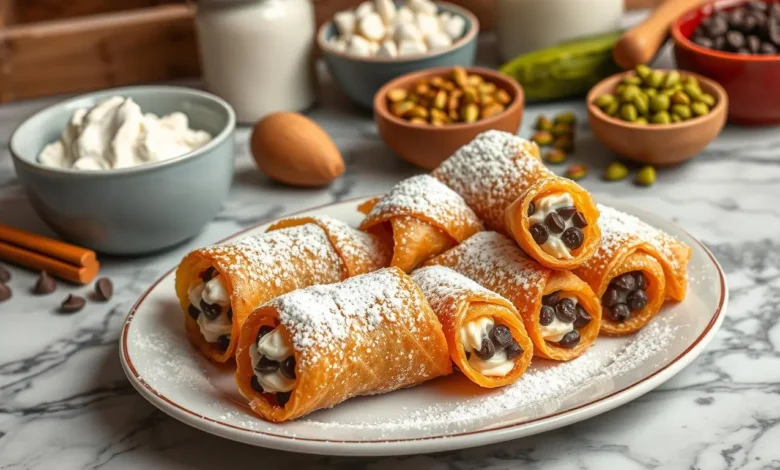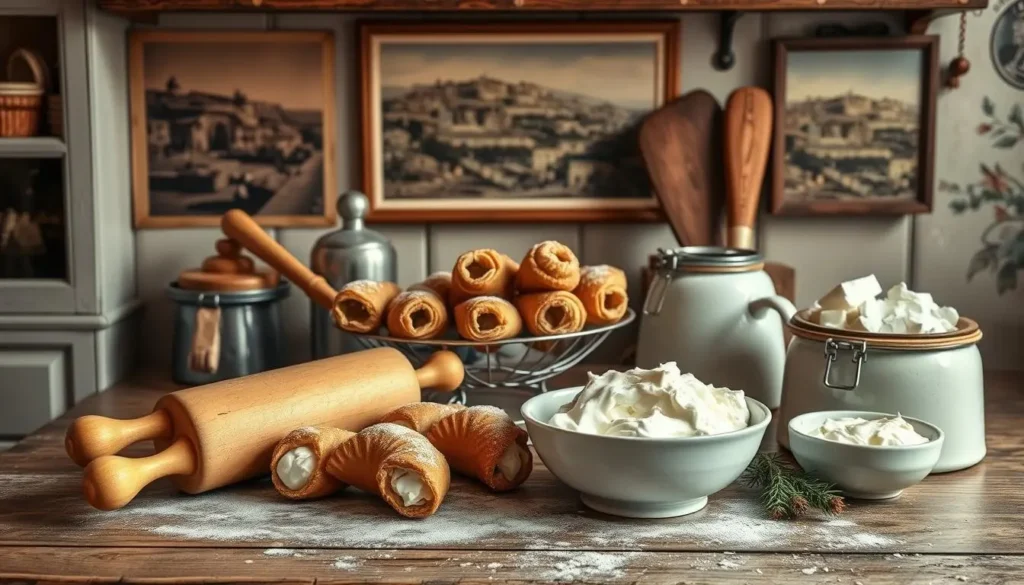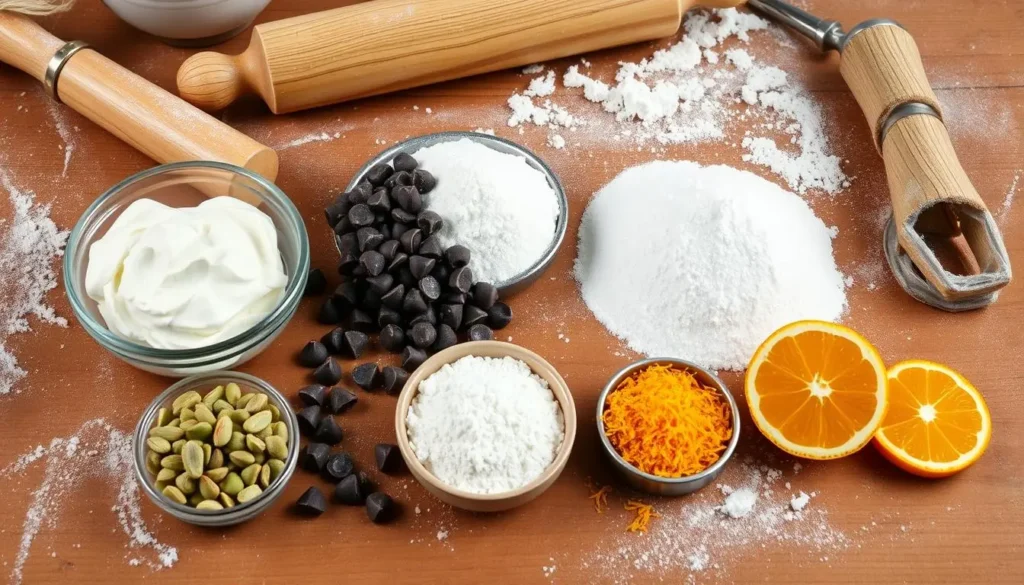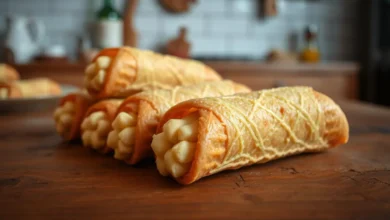How to Make Authentic Cannoli: A Step-by-Step Guide

Learn the secrets to making perfect, crispy cannoli shells and rich, creamy filling. This guide is for everyone, whether you’re experienced or new to baking. You’ll discover how to make authentic, homemade cannoli from scratch. Get ready to enjoy the ultimate Italian dessert that will wow your loved ones.
Key Takeaways
- Learn the secrets to crafting the perfect cannoli shells with a crispy texture
- Discover the traditional ricotta filling and explore creative flavor combinations
- Understand the step-by-step process of assembling and decorating your homemade cannoli
- Gain tips and tricks for perfecting your cannoli-making skills
- Explore the rich history and significance of this iconic Italian dessert
Unraveling the History of Cannoli
The history of cannoli is fascinating, going back centuries to Sicily. This Italian pastry started as a simple treat and now is loved everywhere. It has won the hearts of many with its delicious taste.
Origins and Significance
Cannoli began in Sicily’s ancient culinary traditions. Pastry chefs in Palermo’s convents created them. They used the island’s dairy to make a creamy filling, wrapped in a crispy shell.
The shape of cannoli symbolizes fertility and prosperity. It became a key part of Sicilian celebrations and festivals.
From Sicily to the World
Sicilian immigrants took cannoli-making with them as they moved around the world. The history of cannoli became known globally. Now, you can find cannoli in Italian-American bakeries and cafes from New York to California.
Today, the origins of cannoli are celebrated everywhere. This cannoli history continues to inspire pastry lovers of all ages.
“Cannoli are not just a pastry, but a piece of Sicilian culture and history.”

A beautifully arranged vintage Italian kitchen setting, showcasing traditional cannoli-making tools like rolling pins, pastry tubes, and a bowl of ricotta cheese, surrounded by historical images of Sicilian landscapes and cultural elements, soft warm lighting creating a nostalgic atmosphere.
Essential Ingredients and Equipment
Making authentic cannoli at home needs the right ingredients and tools. Whether you’re an experienced baker or new to cannoli making, knowing what you need is crucial. This ensures your cannoli turns out perfectly.
Cannoli Ingredients
The quality of ingredients is key to making great cannoli. Here’s what you’ll need:
- Flour – Use all-purpose flour or a mix of all-purpose and semolina flour for the best shells.
- Ricotta Cheese – Choose fresh, high-quality ricotta for a creamy filling.
- Sugar – Add powdered or granulated sugar for sweetness in both the shell and filling.
- Eggs – Eggs help the dough come together and make the shells crispy.
- Flavoring Extracts – Vanilla, cinnamon, or citrus extracts can enhance the filling’s flavor.
- Chocolate Chips or Candied Fruits – These add a nice texture and taste to the filling.
Cannoli Equipment
Having the right tools is important for making great cannoli:
- Cannoli Tubes – These are used to shape the shells during frying.
- Frying Pan or Deep Fryer – A good pan or deep fryer is needed for frying the shells right.
- Pastry Bag and Tips – These make filling the shells easy.
- Cooling Rack – A sturdy rack helps keep the shells crispy as they cool.
- Mixing Bowls and Utensils – Good mixing bowls and utensils are needed for dough and filling prep.
With the right ingredients and tools, you can make delicious cannoli at home.

A rustic wooden table displaying an array of fresh cannoli ingredients: a bowl of ricotta cheese, powdered sugar, chocolate chips, crushed pistachios, and orange zest. Surrounding the ingredients are essential equipment items such as a rolling pin, a pastry bag, and cannoli molds, all set against a softly lit kitchen background with flour dust scattered on the surface.
Mastering the Perfect Cannoli Shell
Making the perfect cannoli shell is key to this Italian favorite. It starts with the right flour mix and ends with a crispy fry. Learning how to make these shells is crucial for a delicious treat.
Preparing the Dough
The dough is the heart of a great cannoli shell. Mix all-purpose flour, sugar, and a bit of salt in a big bowl. Add cold white wine or sparkling water slowly, until it’s smooth and easy to work with. Knead it a bit, then cover and rest for 30 minutes before shaping.
Shaping and Frying the Shells
Split the dough into pieces and roll each one thin with a rolling pin. Wrap the dough around cannoli tubes or metal forms, sealing with water. Fry the shells in hot oil (350°F to 375°F) until they’re golden, about 2-3 minutes each side. Let them cool before filling.
The secret to great cannoli shells is the dough and how you shape and fry them. With practice, you’ll get the hang of making crispy, golden shells. Then, fill them with your favorite creamy filling.
Cannoli: The Rich and Creamy Filling
At the heart of every exceptional cannoli lies the rich and creamy filling. Mastering the art of crafting the perfect cannoli filling is key. This section will guide you through the secrets to achieving cannoli perfection.
Traditional Ricotta Filling
The traditional ricotta filling is the foundation of great cannoli. It combines high-quality ricotta cheese with sugar and flavorings. This classic filling balances creaminess and sweetness perfectly.
Carefully blending the ingredients ensures a smooth and velvety texture. This texture melts in your mouth with every bite.
Variations and Flavor Combinations
While the classic ricotta filling is a favorite, there are many exciting possibilities. Explore creative flavor combinations that will tantalize your taste buds. Options range from chocolate-infused fillings to citrusy notes of lemon or orange.
Incorporate seasonal fruits, nuts, or even liqueurs to create unique and memorable cannoli. The options are endless.
| Filling Flavor | Description |
|---|---|
| Ricotta Filling | The traditional, creamy ricotta-based filling with just the right balance of sweetness. |
| Chocolate Chip Cannoli Filling | A rich, indulgent filling made with creamy ricotta and decadent chocolate chips. |
| Lemon Cannoli Filling | A bright and tangy filling that combines the smooth ricotta with the zesty flavor of fresh lemon. |
| Pistachio Cannoli Filling | A unique and flavorful filling that incorporates the nutty goodness of pistachios. |
Regardless of the filling you choose, the key to exceptional cannoli lies in the perfect balance of flavors and textures. Experiment with different combinations to find the ones that truly captivate your taste buds and bring your homemade cannoli to new heights of deliciousness.
Assembling Your Homemade Cannoli
Making your own cannoli is a fun journey. The last step is putting them together perfectly. Whether it’s for a special event or just for fun, getting it right is key to that Italian taste and look.
First, fill the crispy shells with creamy ricotta. Use a pastry bag with a small tip to pipe the filling into each shell. Make sure to fill them evenly, but don’t overdo it to avoid spills.
- Prepare the ricotta filling as you like.
- Put the filling in a pastry bag with a small tip.
- Pipe the filling into each shell, filling them evenly.
- Gently tap the shells to remove air and make them smooth.
After filling, add your favorite toppings. You can use powdered sugar, melted chocolate, or chopped nuts. Try different things to make your cannoli special.
“The true joy of making cannoli lies in the final assembly, where all the flavors and textures come together in perfect harmony.” – Chef Rosa Marchetti, renowned Sicilian pastry expert
With care and patience, you’ll make cannoli that will wow your guests. Enjoy your delicious homemade cannoli.
Decorating and Garnishing Cannoli
Make your homemade cannoli special with creative decorations and garnishes. Try toppings like powdered sugar, chopped nuts, chocolate shavings, or candied citrus peels. Learn to present your cannoli in stunning ways, making them the highlight of any dessert table.
Creative Toppings and Presentations
Decorating cannoli is an art that can make your dessert pop. Start with powdered sugar for a classic look. Or, add a chocolate ganache or caramel sauce for something new. Sprinkle pistachios, toasted almonds, or shredded coconut for texture.
For a citrusy flavor, use candied orange peel or lemon zest on top. When presenting, try arranging them on a platter or in a circle. You can also layer them with berries or whipped cream for a stunning look.
“The secret to serving the perfect cannoli is in the presentation. It’s the final touch that transforms a delicious treat into a work of art.”
The decorating and garnishing of your cannoli lets you show off your creativity. Try different flavors and techniques to find the best way to serve your homemade cannoli.
Tips for Perfecting Your Cannoli
Making delicious homemade cannoli needs attention to detail and a bit of cooking skill. If you want to get better at making cannoli, here are some tips and tricks. They will help you make your cannoli even better.
- Chill Your Ingredients – Chilling your ingredients, especially the ricotta, before you start is key. It makes a big difference in how your cannoli taste and feel.
- Carefully Manage Frying Temperature – Keeping the frying temperature just right is important. It helps your cannoli shells turn golden brown and crispy. Use a thermometer to check the oil’s temperature.
- Embrace Creative Fillings – Don’t just stick to the classic ricotta filling. Try new flavors to make your cannoli interesting and fun.
| Tip | Benefit |
|---|---|
| Chill Your Ingredients | Enhances texture and flavor of the cannoli |
| Carefully Manage Frying Temperature | Achieves the perfect golden-brown hue and crisp texture |
| Embrace Creative Fillings | Keeps your cannoli offerings fresh and exciting |
Using these tips and techniques will help you make cannoli as good as those in an Italian pastry shop. The secret is in the details and being open to trying new things.
“The secret to making truly exceptional cannoli lies in the perfect balance of flavors and textures.”
Serving and Storing Cannoli
Serving homemade cannoli is an art. To keep them perfect, place them on a platter with powdered sugar or chocolate sauce. This makes them look and taste great.
Storing cannoli right is key to keeping them fresh. Enjoy them within a day or two for the best taste. Store unfilled shells in an airtight container for up to a week.
For longer storage, freeze the shells for 2 months. Thaw them at room temperature and fill with fresh ricotta. This way, you can enjoy them whenever you want.
FAQ
What are the essential ingredients for making authentic cannoli?
To make real cannoli, you need flour, sugar, eggs, and ricotta cheese. Don’t forget citrus zest and chocolate chips. You’ll also need special tools like cannoli tubes to shape the shells.
How do I prepare the perfect cannoli dough?
Mix flour, sugar, eggs, and a bit of wine or vinegar for the dough. Knead it until it’s just right. Then, let it rest before rolling and shaping the shells.
What’s the best way to fry the cannoli shells?
Heat oil to 375°F for frying the shells. Wrap the dough around the forms or tubes carefully. Fry until they’re golden and crispy.
How do I make the perfect cannoli filling?
The filling is sweetened ricotta cheese mixed with lemon zest, chocolate chips, or candied fruit. Use top-notch ricotta and whip it until it’s smooth and creamy.
Can I make cannoli ahead of time?
Yes, you can make the shells and filling ahead. But assemble them just before serving. Store the shells in an airtight container for a few days. Refrigerate the filling for up to a week.
What are some creative ways to decorate and garnish cannoli?
Decorate cannoli with powdered sugar or try more elaborate toppings like nuts, chocolate shavings, or candied citrus peels. You can also drizzle them with chocolate or caramel sauce for extra indulgence.
How long do homemade cannoli last?
Enjoy homemade cannoli fresh for the best taste. They last 2-3 days when stored right. Keep the shells and filling separate. Assemble just before serving for the best texture and freshness.



One Comment